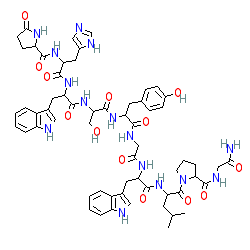GtoPdb is requesting financial support from commercial users. Please see our sustainability page for more information.
|
Synonyms: GnRH | gonadoliberin | gonadotropin releasing hormone | LH-RH (LHRH)
Compound class:
Endogenous peptide in human, mouse or rat
Species: Human, Mouse, Rat
Ligand Activity Visualisation ChartsThese are box plot that provide a unique visualisation, summarising all the activity data for a ligand taken from ChEMBL and GtoPdb across multiple targets and species. Click on a plot to see the median, interquartile range, low and high data points. A value of zero indicates that no data are available. A separate chart is created for each target, and where possible the algorithm tries to merge ChEMBL and GtoPdb targets by matching them on name and UniProt accession, for each available species. However, please note that inconsistency in naming of targets may lead to data for the same target being reported across multiple charts. ✖
View more information in the IUPHAR Pharmacology Education Project: gnrh |
|
|||||||||||||||||
| Natural/Endogenous Targets | |||
|
|||
| Selectivity at GPCRs | ||||||||||||||||||||||||||||||||||||||||||||||||||||||||||||||||||||||||||||||||||||||||||||||||||||||||||||||||||||||||||||||||||||||||||||||||||||||||||||||||||||||||||||||||||||||||||||||||||||||||||
| Key to terms and symbols | Click column headers to sort | |||||||||||||||||||||||||||||||||||||||||||||||||||||||||||||||||||||||||||||||||||||||||||||||||||||||||||||||||||||||||||||||||||||||||||||||||||||||||||||||||||||||||||||||||||||||||||||||||||||||||
|
||||||||||||||||||||||||||||||||||||||||||||||||||||||||||||||||||||||||||||||||||||||||||||||||||||||||||||||||||||||||||||||||||||||||||||||||||||||||||||||||||||||||||||||||||||||||||||||||||||||||||
| Additional information and targets (data relate to human unless otherwise stated) | ||
| Description | Data | Reference |
| Potency order of endogenous ligands at GnRH1 receptor | GnRH I (GNRH1, P01148) > GnRH II (GNRH2, O43555) | 9 |
| Potency order of endogenous ligands at GnRH2 receptor | GnRH II (GNRH2, O43555) > GnRH I (GNRH1, P01148) | 8 |
| Targets where the ligand is described in the comment field | |
| Target | Comment |
| glutaminyl-peptide cyclotransferase | This glutaminyl cyclase is a soluble enzyme (soluble QC, or sQC) that catalyses post-translational pyroglutamation (cyclization of N-terminal glutamine) of substrate proteins such as CCL2 (CCL2, P13500) and CX3CL1 (CX3CL1, P78423) and a number of neuroendocrine peptides (e.g. TRH (TRH, P20396) and GnRH I (GNRH1, P01148)) [5]. Pyroglutamation is known to enhance protein stability and bioactive conformation, and dysregulated pyroglutamation has been associated with human diseases, including neurodegeneratrive diseases and cancer [3-4,14-15]. Selective inhibitors are proposed to reduce post-translational pyroglutamate modification of amyloid-β that is associated with amyloid-β neurotoxicity [2]. |
| Ligand mentioned in the following text fields |
| Gonadotrophin-releasing hormone receptors overview |
| Gonadotrophin-releasing hormone receptors comments |







